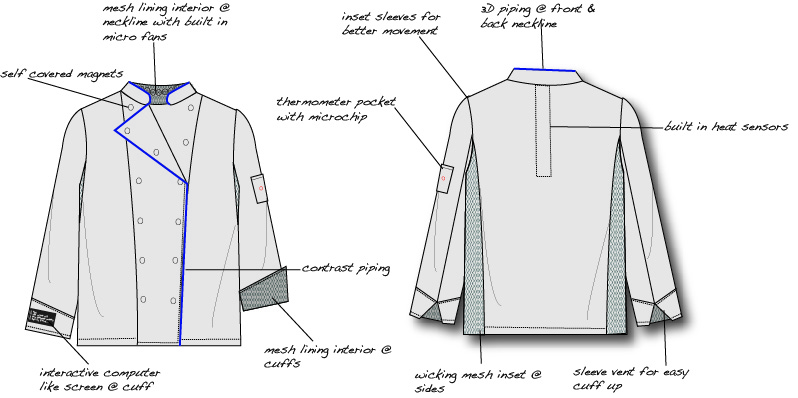The Kitchen Of The Future
Editor’s Note: As part of our Kitchen of The Future series, we asked our Fashionista, Roberta Donato, to think about how new fabric and wearable technology might affect the future of chefware for chefs and foodies alike. Here is what she has to say on the matter.
Several decades ago when we thought of what people would be wearing in the future, our imagination went something like this; clean angular lines, metallic, puffy shoulder seams and anything space-agey, almost Jetson(esque). Back then, we probably never imagined that beyond changes to silhouette and shape of the garment, there would be the evolution of textiles and fabrics. Now there are fabrics made out of milk jugs and coffee beans, plastic bags and even beer bottles! There are incredible technological innovations in sports wear textiles to enhance performance and don’t forget about fabrics with moisturizer, perfume and anti-aging properties. It seems that every industry, – beauty, sports, science, fashion – is taking advantage of these new “smart fabrics”. So what about the food industry? How can these innovations be used to better the performance of a kitchen? Is it applying these textiles and fabrics in the uniform of the chef or is it a wearable technology, say a built-in microchip or Apple Watch App?
Let me take you back to the mid-19th century, where Marie-Antoine Careme, a popular French chef, is credited for creating the traditional and still current chef’s uniform (to compliment the “toque” (traditional hat) which dates back to 16th century). Did you know that the folds of the toque are said to represent the many different ways a chef knows how to cook an egg? The white coat is double breasted which can be reversed in case of any stains, which happens quite often I would imagine; the fabric is a heavy cotton which protects the chef from flames; and the pants are checkered to hide any occasional spills.
If I were to redesign chefware, more specifically an update to the white coat, applying these new technologies I would start with the fact that kitchen is a very hot place, so why not add a fabric to wick away moisture, in this case, chef sweat! You’ve probably heard about these fabrics mostly in sports apparel. Wicking fabric pulls moisture from the body to the exterior of the garment so it can more easily evaporate. These wicking fabrics are mainly made out of polyester fibers, which we would not want too much of in a kitchen since they melt to your body – OUCH!. Melted Polyester with your Chicken Cordon Bleu, anyone? Natural fibers, like cotton and linen, are more breathable, resistant to washes, and burns slower than a synthetic fabric. The body of the coat would still be mostly cotton, but I would include insets of high technology wicking polyester mesh in high body heat zones. And how about built in microscopic fans in the back neckline? Charged by your own body heat, they would go off once body sensors hit a certain temperature? I would change the buttons to self-fabric covered magnets for easy on/off and I would also add 3D printed piping around neckline and front, because I am a designer, after all…
I mentioned wearable technology in the beginning of this text. I must confess I am not the most tech savvy person, I still haven’t figured out the mystical “iCloud”, but there is something so appealing about technology disguised as fashion. I imagine that the thermometer pocket (on chef coats’ left sleeve) would include a sewn in microchip that could be set using an App on your Apple Watch or Smartphone to sense/set temperatures, set timers, and even record new concoctions. Or what if the wearer’s cuff had a computerized screen you could read or dictate recipes to, read oven temperatures, sew timers, all at arms length, literally! What if the front of the house could let the chef know when table 4 is ready for their apettizer using an app or built in screen?
Keep Eating! Keep Innovating!
What do you think a chef will be wearing in the future? Let us know all about it in the comments or on Facebook.
The Culinary Exchange can also be found on Twitter, Instagram, Pinterest, Google+ and YouTube.
Come On! Follow Along!






Very interesting approach and, as we can see, there´s no limits to what creativity can do regarding fashion! Congrats on this new fashionista´s point of view !
Hi Antonella. We totally agree! We love having a fashionista in the kitchen to give us a different perspective! Thanks for stopping by and commenting!
Ha! And I, innocently enough, thought a chef’s jacket was simply that, a white cotton jacket. So many possibilities!
The adorable article, custom chef coats self-covered magnets, and mesh lining interior cuffs very beautiful.